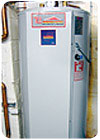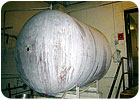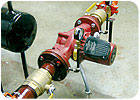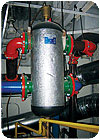
Figure 1. The
graphic interface for the controls system originally installed to control the
new boiler equipment. The team is now expanding the system to handle lighting,
security, and cooling control for the school as well.

Figure 2. The
new 119-gal indirect water heater provides quasi-instantaneous water heating
during periods of high demand.
The project was at Yeshiva & Mesivta Ch’san Sofer, a private elementary/high school in Brooklyn. The original 5 MMBtuh oil-fired boiler was installed in 1966 when fuel oil cost the school $0.04/gal. Although the boiler was still functional, its $18,000/yr appetite for oil at today’s pricing was straining the school’s budget. As is often the case, the boiler took all the blame for the system’s performance, and the school’s administration finally decided it had to go, and they followed through by soliciting bids for a replacement boiler.

Figure 3. The existing 1,400-gal domestic hot water tank
following asbestos removal.
A Broader Vision
Instead of just pricing out the boiler replacement, Fischman and Rotenberg arranged to inspect the entire heating system including piping, circulators, controls, and provisions for domestic water heating. Then they developed a comprehensive proposal to transform the mechanical room from its vintage ‘60s technology into a synergy of modern hydronic hardware and Internet-accessible controls.Their vision of the system makeover was not initially shared by the school’s administration. Their proposal and associated pricing was significantly higher than competing proposals for simply replacing the boiler. This is when Fischman provided the school board with justification of why the boiler was not the sole issue behind the school’s high heating bills. He convinced the administration that simply replacing the boiler was like installing a brand new engine in a ’66 Chevy with 300,000 miles on it. Eventually, his passionate professionalism convinced the school’s administration to take the long view and upgrade the entire system.

Figure 4. A 3-hp circulator operated by a VFD provides injection
mixing to regulate system water temperature using outdoor reset control.
Beyond Replacement
The makeover began with a complete asbestos abatement procedure. This was followed by removal of existing equipment, some of which had to be cut up with torches to get it through the mechanical room’s service door. The building’s 10,000-gal fuel oil storage tank was also decommissioned.A full building survey revealed that although the original boiler was rated at 5 MMBtuh, the existing fintube convectors had been heating the building for the last 40 years dissipating no more than 1.3 MMBtuh at design load conditions. Based on the building survey, a single 2 MMBtuh boiler was more than capable of handling both the heating and domestic hot water loads. However, the proposal included a second boiler to provide backup, should either boiler be turned off for service. A new 4-in. medium pressure gas service also supplied the new boilers.
Coupling new boilers to an old system always presents some issues. One is the possibility of sediment from existing steel piping fouling the heat exchangers in the new boilers. Another issue is flow. The copper tube replacement boilers needed sustained minimum flow rates when operating, due to much lower metal and water content than the old boiler.
Fischman and Rotenberg selected a Caleffi Hydro Separator to provide hydraulic separation between the existing system and boilers, ensuring that the latter always operated at sufficient flows regardless of flow to the space heating system. The hydraulic separator also provides central air separation and dirt separation for the system.
The existing distribution system used redundant circulators, both of which had more than exceeded their design life expectancy. These were replaced with a staged pumping system consisting of one 5-hp and one 7-hp vertical inline circulator. The 5-hp circulator operates the entire system when the outdoor temperature is above 20°F. When the outdoor temperature drops below 20°, the 7-hp circulator takes over. Controls allow either non-operating circulator to come online immediately if the other circulator fails.
Injection mixing controls the temperature of the water supplied to the distribution system. The speed of a 3-hp wet rotor circulator is adjusted by a VFD, which itself is controlled by a 0 to 10 VDC signal from the system controls. This circulator shuttles hot water from the system side of the hydraulic separator to the existing distribution piping. This mixing assembly allows full outdoor reset of the distribution supply temperature while also protecting the boilers from sustained flue gas condensation.

Figure 5.
A hydro separator interfaces new boilers with an
old distribution system providing air, dirt, and hydraulic separation.
Quasi-Instantaneous Domestic Hot Water
Space heating isn’t the only load to benefit from the makeover. The original system used a 1,400-gal domestic hot water tank coupled to a heat exchanger inside the old boiler. This tank occupied considerable space in the mechanical room and, like the boiler, proved to be very oversized for its load.In the new system, a 119-gallon indirect tank heats domestic water. Upon a call for domestic water heating a separate circulator carries high temperature water from the new boiler through the shell of this tank. Nine helical coils of copper tubing are suspended within the tank. The large surface area of these coils allow very high rates of heat transfer, and thus quasi-instantaneous water heating, eliminating need for a large standby volume. This change saves space and greatly reduces standby heat loss.

Figure 6. Rotenberg’s
diagram of the mechanical room upgrades.
Just an IP Address Away
The original system used pneumatic controls. Before its removal, the pneumatic system was leaking air to the point where the air compressor was in almost continuous operation.The new system is controlled by a Lon®-based iWorx BAS. The initial control deployment handled functions such as injection mixing and boiler protection within the mechanical room, as well as an array of 45 three-way zone valves and associated room temperature sensors that control all zoning within the building. iWorx zone control modules are located in various areas of the building and connected into a network with a two-wire communications bus. The entire system can be monitored and adjusted via the Internet.
The Yeshiva system is currently in its first heating season and working well. So well that the school’s administration has retained ENY Mechanical to convert the building’s cooling, lighting, and security to the iWorx control platform.
As this is being written, the school is planning its annual fundraising dinner. One of the unusual features of this year’s event will be a presentation on the school’s new heating system, including tours of the mechanical room by Fischman and Rotenberg. Although many of those viewing the new hardware may not understand its significance, the synergy it provides ensures Yeshiva of substantial reductions in fuel usage as well as improved comfort. In the end, Fischman and Rotenberg delivered a lesson on modern heating technology, and the school learned it well.
